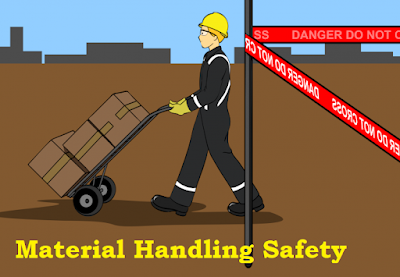Material Handling Safety:
Key Factors for a Safe Workplace
Material Handling Safety:
Key Factors for a Safe Workplace
Material
handling is one of the frequent activity in any industry and it poses critical
risk. Material handling refers to the movement, storage, and control of
materials and products throughout the manufacturing, distribution, and disposal
processes. As material handling equipment and systems continue to evolve, so
does the need for employees to understand the importance of material handling
safety. Proper training and adherence to best practices can significantly
reduce the risk of workplace accidents and injuries, making the workplace safer
for everyone.
Important of Material Handling Safety
Material handling activities pose a variety of risks to employees, including musculoskeletal disorders, crush injuries, and falls. In some cases, these risks can be fatal. According to the Bureau of Labor Statistics, material handling was the cause of nearly 40% of all workplace accidents that resulted in days away from work in 2020. As a result, employers must take steps to ensure the safety of their employees and minimize the risk of workplace accidents and injuries.
Key Factors to Consider in Material Handling Safety
To promote material handling safety, employers should consider the following key factors:
Selection of Equipment:
The right equipment must be selected based on the specific needs
of the task and the materials being handled. It is important to ensure that
equipment is well-maintained and inspected regularly to ensure that it operates
safely and effectively. The quality of equipment is also one of the important parameter
which supports the safe execution and employee safety.
Construction Safety Pictorial Guidelines
Capacity of the Load:
Overloading material handling equipment can result in equipment failure, causing injury to employees or damage to the equipment. It is important to understand the load capacity of each piece of equipment and to use it only within those limits. SLI – Safe Load Indicator must be in place for the mechanical material handling equipment's.
Safe Lifting Techniques:
Employees must be trained in proper lifting techniques to reduce the risk of musculoskeletal disorders. This includes using their legs to lift, keeping the load close to their bodies, and avoiding twisting and bending at the waist. The manual handling of loads to be avoided as much possible.
Hazard Awareness:
Employees must be made aware of the hazards associated with material
handling, such as moving equipment, sharp edges, and falling objects. They must
also be trained to recognize and respond to emergency situations, such as
equipment malfunctions or spills. Required signage to be displayed in the work
area.
PPE:
Personal Protective Equipment (PPE) such as Gloves, Safety Glasses, and Safety Helmets must be worn by employees to protect them from the hazards associated with material handling. Employers must also ensure that PPE is properly maintained and replaced when necessary. The usage of right PPE to be ensured.
Material Handling Safety Best Practices
To promote material handling safety, Employers should adopt the following best practices:
Implementation of Material Handling Safety Plan:
Developing & Implementing a comprehensive material handling safety plan is the first step in promoting safety in the workplace. This plan should include policies, procedures, and protocols for safely handling materials and equipment.
Conduct Periodic Safety Training:
Periodic safety training on material handling is
essential to promote awareness of the hazards associated with material handling
and to ensure that employees understand how to safely perform their tasks.
Definitions of Terms in Chemical Safety
Regular Equipment Inspection:
Regular equipment inspections by the competent authority and pre-use check by the user help to identify any potential hazards and ensure that equipment is in good working condition. Employers should establish a schedule for inspecting equipment and include this in their material handling safety plan.
Safe Storage:
Safe storage of materials is important to prevent accidents and injuries. Employees must be trained on the proper storage methods for each type of material, including the use of proper labeling and signage. Adequate space between materials to be maintained for the safe handling.
Encourage Employee Involvement:
Employee involvement is key to promoting material
handling safety. Employers should encourage employees to report any hazards or
near misses, and to suggest ways to improve safety in the workplace.
Crane Lifting Hand Signal Guide
Conclusion
Material handling safety is essential to protecting employees from accidents and injuries in the workplace. Employers must adopt best practices and provide regular training to ensure that employees understand the importance of material handling safety and are equipped with the knowledge and skills needed to perform their tasks safely. By considering key factors such as equipment selection, load capacity, proper lifting techniques, hazard awareness, and PPE, employers can significantly reduce the risk of workplace accidents and create a safer working environment for their employees.
Promoting
material handling safety is not only the right thing to do, it also makes good
business sense. By reducing workplace accidents and injuries, employers can
reduce their risk of costly liabilities and improve their bottom line. By
implementing best practices and providing regular training, employers can
create a culture of safety that will benefit everyone, from employees to
managers to shareholders.
"Material
Handling Safety: Best Practices and Key Factors for a Safe Workplace"
"Preventing
Workplace Accidents through Material Handling Safety Awareness and
Training"
"Maximizing
Material Handling Efficiency and Safety: A Guide to Best Practices"
"Protecting
Employees with Comprehensive Material Handling Safety Plans and Procedures"
"Reducing
Workplace Injuries with Effective Material Handling Safety Strategies"

No comments:
Post a Comment